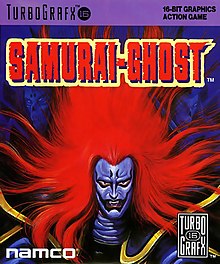Samurai-Ghost
Samurai-Ghost[lower-alpha 1] is a 1992 hack and slash video game released by Namco for the TurboGrafx-16. It is the sequel to Genpei Tōma Den. It was released on the Wii Virtual Console in North America on October 29, 2007, and in Europe on November 2, 2007.
| Samurai-Ghost | |
|---|---|
 | |
| Developer(s) | Now Production |
| Publisher(s) | |
| Designer(s) | H. Chatani |
| Programmer(s) | Naoki Higashio |
| Artist(s) | Masaru Moriya Takashi Yoshida |
| Composer(s) | Miyoshi Okuyama |
| Series | Genpei Tōma Den |
| Platform(s) | TurboGrafx-16 |
| Release | |
| Genre(s) | Hack and slash |
| Mode(s) | Single-player |
Gameplay
.png)
As with the previous game, the player controls the resurrected samurai Taira no Kagekiyo, defeating demons and monsters across several levels. Given his undead nature, Kagekiyo has access to supernatural powers such as levitation and the ability to cast energy projectiles.
Samurai-Ghost has a similar plot to its predecessor, in that Kagekiyo fights against Minamoto no Yoshitsune, Saitō Musashibō Benkei, and his arch enemy Minamoto no Yoritomo. Kagekiyo now also faces Minamoto no Yoshinaka (also known as Kiso no Yoshinaka), who commits seppuku when defeated.
Development and release
Reception
| Reception | ||||||||||||||||||||||||||||||
|---|---|---|---|---|---|---|---|---|---|---|---|---|---|---|---|---|---|---|---|---|---|---|---|---|---|---|---|---|---|---|
| ||||||||||||||||||||||||||||||
Notes
References
- Harris, Steve; Semrad, Ed; Alessi, Martin; Williams, Ken (February 1993). "Review Crew - Turbo Duo - Samurai-Ghost". Electronic Gaming Monthly. No. 43. Sendai Publishing. p. 26.
- Whitehead, Dan (3 November 2007). "Virtual Console Roundup • Page 2". Eurogamer. Gamer Network. p. 2. Archived from the original on 21 August 2016. Retrieved 17 July 2020.
- "源平討魔伝 巻ノ弐 (PCエンジン) - レビュー・評価・感想". Famitsu (in Japanese). Kadokawa Game Linkage. 2020. Retrieved 2020-07-17.
- Loveday, Leigh (April 2013). "We Love Old Games - Samurai Ghost (TurboGrafx)". GamesMaster. No. 262. Future plc. pp. 94–95.
- Provo, Frank (5 November 2007). "Samurai Ghost Review". GameSpot. CBS Interactive. Archived from the original on 9 September 2014. Retrieved 17 July 2020.
- M. Thomas, Lucas (29 October 2007). "Samurai Ghost (Virtual Console) Review". IGN. Archived from the original on 1 November 2007. Retrieved 17 July 2020.
- van Duyn, Marcel (29 October 2007). "Samurai Ghost Review (TG-16)". Nintendo Life. Gamer Network. Archived from the original on 30 December 2019. Retrieved 17 July 2020.
- "源平討魔伝 巻ノ弐". Gekkan PC Engine (in Japanese). No. 39. Shogakukan. March 1992.
- Nini, Nourdine; Demoly, Jean-Marc (June 1992). "PC Engine - Equinox Warrior II". Joypad (in French). No. 9. Yellow Media. pp. 110–111.
- Demoly, Jean-Marc (June 1992). "Consoles News: Equinox Warrior II (PC Engine)". Joystick (in French). No. 28. Sipress. p. 129.
- "源平討魔伝 巻ノ弐". Marukatsu PC Engine (in Japanese). Kadokawa Shoten.
- "PC Engine All Catalog '93 10月号特別付録 - 源平討魔伝 巻ノ弐". PC Engine Fan (in Japanese). Vol. 6 no. 10. Tokuma Shoten. 1 October 1993. p. 11.
- Reischmann, Robert (May 1993). "Turbo Duo - Samurai Ghost" (PDF). Play Time (in German). No. 23. Computec. p. 120.